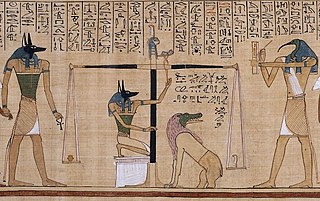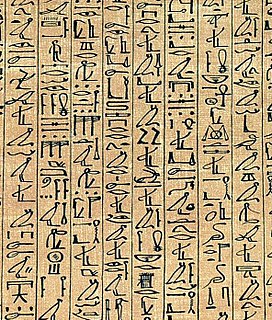 W
WThe Book of the Dead is an ancient Egyptian funerary text generally written on papyrus and used from the beginning of the New Kingdom to around 50 BCE. The original Egyptian name for the text, transliterated rw nw prt m hrw, is translated as Book of Coming Forth by Day or Book of Emerging Forth into the Light. "Book" is the closest term to describe the loose collection of texts consisting of a number of magic spells intended to assist a dead person's journey through the Duat, or underworld, and into the afterlife and written by many priests over a period of about 1,000 years.
 W
WAncient Egyptian afterlife beliefs were centered around a variety of complex rituals that were influenced by many aspects of Egyptian culture. Religion was a major contributor, since it was an important social practice that bound all Egyptians together. For instance, many of the Egyptian gods played roles in guiding the souls of the dead through the afterlife. With the evolution of writing, religious ideals were recorded and quickly spread throughout the Egyptian community. The solidification and commencement of these doctrines were formed in the creation of afterlife texts which illustrated and explained what the dead would need to know in order to complete the journey safely.
 W
WAmmit was a demoness and goddess in ancient Egyptian religion with a body that was part lion, hippopotamus, and crocodile—the three largest "man-eating" animals known to ancient Egyptians. A funerary deity, her titles included "Devourer of the Dead", "Eater of Hearts", and "Great of Death". Ammit lived near the scales of justice in Duat, the Egyptian underworld. In the Hall of Two Truths, Anubis weighed the heart of a person against the feather of Ma'at, the goddess of truth, which was depicted as an ostrich feather. If the heart was judged to be not pure, Ammit would devour it, and the person undergoing judgment was not allowed to continue their voyage towards Osiris and immortality. Once Ammit swallowed the heart, the soul was believed to become restless forever; this was called "to die a second time". Ammit was also sometimes said to stand by a lake of fire. In some traditions, the unworthy hearts were cast into the fiery lake to be destroyed. Some scholars believe Ammit and the lake represent the same concept of destruction.
 W
WThe ancient Egyptians believed that a soul was made up of many parts. In addition to these components of the soul, there was the human body.
 W
WThe Assessors of Maat were 42 minor ancient Egyptian deities of the Maat charged with judging the souls of the dead in the afterlife by joining the judgment of Osiris in the Weighing of the Heart.
 W
WThe Book of Joseph is an untranslated text identified by Joseph Smith after analyzing Egyptian papyri that came into his possession in 1835. Joseph Smith taught that the text contains the writings of the ancient biblical patriarch Joseph. From the same papyri collection, Smith produced the first part of the Book of Abraham, but was killed before any known part of the Book of Joseph was translated.
 W
WBook of the Dead of Amen-em-hat is a seven-metre-long scroll on display at the Royal Ontario Museum. A Book of the Dead is a key funerary artifact in any tomb from Ancient Egypt. Archaeologists have discovered a wide range of styles and details on scrolls which have led scholars to conclude that the Book of the Dead was an object any Ancient Egyptian ensured they had for their journey to the afterlife. The Ancient Egyptians believed that the recently deceased had to navigate a dangerous underworld to reach the afterlife. The Book of the Dead contained spells and prayers that provided guidance and protection through the journey.
 W
WThe Book of the Dead of Nehem-es-Rataui is, along with the Papyrus Brocklehurst, the most important papyrus in the collection of the Museum August Kestner in Hanover. It contains one of the many traditional versions of the Egyptian Book of the Dead, which differs most significantly from similar papyri in the style of the central scene of the Judgement of the dead.
 W
WCursive hieroglyphs, or hieroglyphic book hand, are a form of Egyptian hieroglyphs commonly used for handwritten religious documents, such as the Book of the Dead. This style of writing was typically written with ink and a reed brush on papyrus, wood, or leather. It was particularly common during the Ramesside Period, and many famous documents, such as the Papyrus of Ani, utilize it. It was also employed on wood for religious literature such as the Coffin Texts.
 W
WThe Joseph Smith Hypocephalus was a papyrus fragment, part of a larger collection of papyri known as the Joseph Smith Papyri, found in the Gurneh area of Thebes, Egypt, around the year 1818. The owner's name, Sheshonq, is found in the hieroglyphic text on said hypocephalus. Three hypocephali in the British Museum are similar to the Joseph Smith Hypocephalus both in layout and text and were also found in Thebes.
 W
WThe Joseph Smith Papyri (JSP) are Egyptian funerary papyrus fragments from ancient Thebes dated between 300 to 100 BC which, along with four mummies, were once owned by Joseph Smith, the founder of the Latter Day Saint movement. Smith said that the papyrus contained the records of the ancient patriarchs Abraham and Joseph. In 1842, Smith published what he said was the first part of the translation of the Book of Abraham. The Book of Joseph is not known to have been translated by Smith.
 W
WMaat or Maʽat refers to the ancient Egyptian concepts of truth, balance, order, harmony, law, morality, and justice. Maat was also the goddess who personified these concepts, and regulated the stars, seasons, and the actions of mortals and the deities who had brought order from chaos at the moment of creation. Her ideological opposite was Isfet, meaning injustice, chaos, violence or to do evil.
 W
WIn Ancient Egyptian religion, Medjed is a god who is mentioned in the Book of the Dead.
 W
WThe Papyrus of Ani is a papyrus manuscript in the form of a scroll with cursive hieroglyphs and color illustrations that was created c. 1250 BCE, during the Nineteenth Dynasty of the New Kingdom of ancient Egypt. Egyptians compiled an individualized book for certain people upon their death, called the Book of Going Forth by Day, more commonly known as the Book of the Dead, typically containing declarations and spells to help the deceased in their afterlife. The Papyrus of Ani is the manuscript compiled for the Theban scribe Ani.
 W
WThe Pyramid Texts are the oldest ancient Egyptian funerary texts, dating to the late Old Kingdom. They are the earliest known corpus of ancient Egyptian religious texts. Written in Old Egyptian, the pyramid texts were carved onto the subterranean walls and sarcophagi of pyramids at Saqqara from the end of the Fifth Dynasty, and throughout the Sixth Dynasty of the Old Kingdom, and into the Eighth Dynasty of the First Intermediate Period.